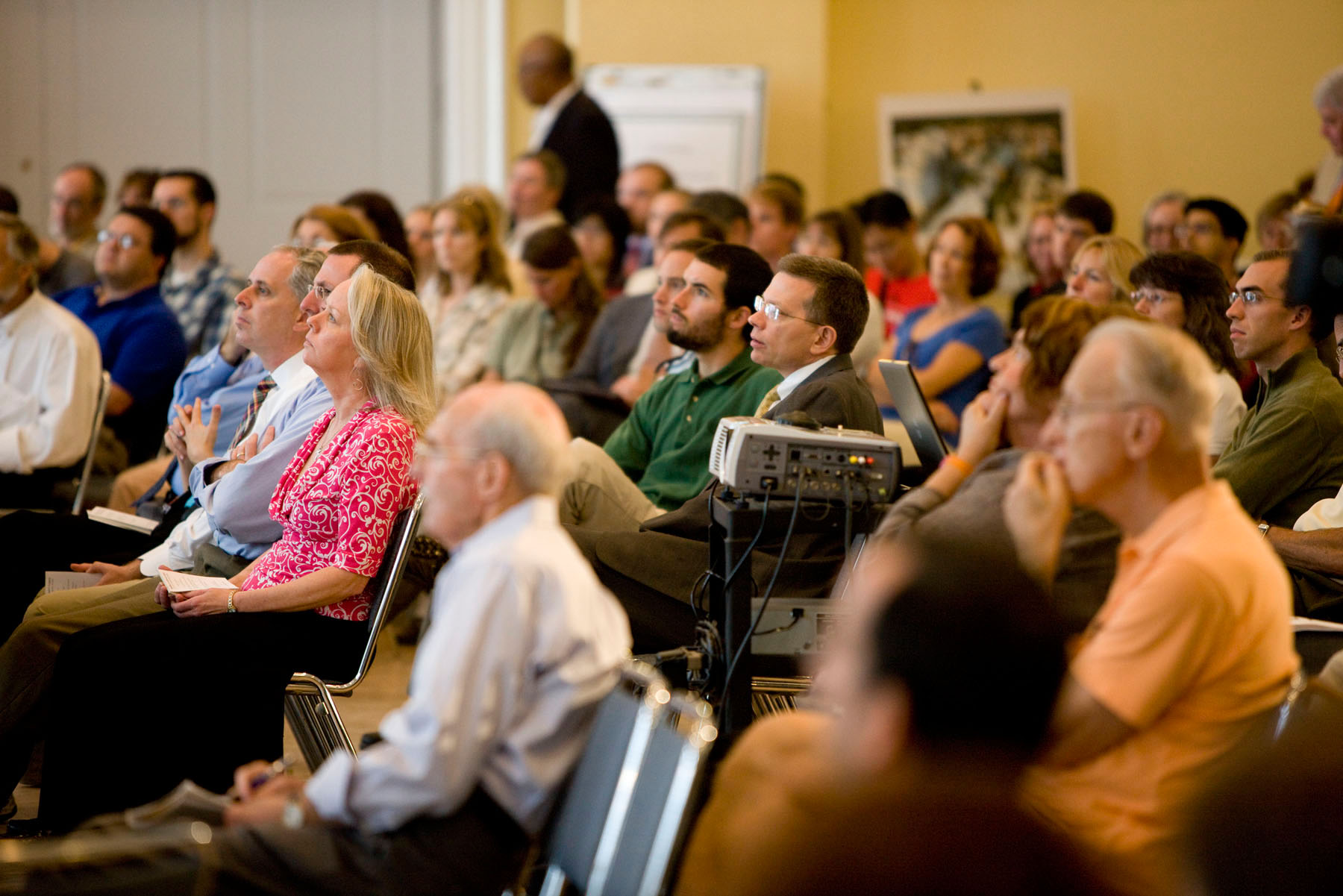- Listen To Audio Of Community Briefing (Flash Player)
September 23, 2008 — Sustainability efforts at the University of Virginia were highlighted at a community briefing Tuesday in the Newcomb Hall Ballroom.
About 200 local residents and members of the University community attended the session. In addition to the formal presentations, they took in booths and displays from student environmental groups and various University departments promoting their steps toward sustainability, and enjoyed a light lunch of locally grown, organic and fair-trade foods.
Presenters included David Neuman, the University architect; Andrew Greene, the sustainability planner in the architect's office; Tom Harkins, chief of environment of care at the Medical Center; and Rebecca White, director of transportation and parking, who explained what their departments were doing toward making the University sustainable.
Neuman highlighted the challenge of sustainability in the face of the University's planned enrollment growth of approximately 150 students a year. With all first-year students required to live in dorms and about 40 percent of the entire student body housed on Grounds, that creates a need for new housing, he noted. The University also needs new science and technology buildings to stay on the vanguard of science education and research, and new arts buildings to accommodate expanding programs.
 Part of the solution to this is "in-fill," expanding the University without expanding its footprint, he said.
Part of the solution to this is "in-fill," expanding the University without expanding its footprint, he said.
"We want to incorporate our growth within our own property," Neuman said.
He said the University's master plan is not a typical presentation of buildings, but a process of how it intends to do business. As part of this, he said the University commissioned its first ever biohabitat survey to determine the most environmentally sensitive areas on its property.
The master plan also includes a historic preservation plan for the 128 buildings that are more than 40 years old. Preservation includes reusing historic buildings, he said, citing Garrett Hall, which will soon go through its fourth renovation; the Rugby Road administration building, which will soon start its third life cycle; and New Cabell Hall, 160,000 square feet of space that will soon be completely renovated.
As mandated by the University's Board of Visitors, all new construction and renovations are designed to incorporate Leadership in Energy and Environmental Design standards. Greene, in his presentation, said LEED standards are based on the use of sustainable building sites; careful use of water, energy and resources; innovation in design; and indoor environmental quality.
Greene said sustainability is measured in terms of equity, economics and the environment. "It is sustainable if it satisfies all three," he said.
He cited as an example the menu served at the luncheon. "You need less energy to transport it. It protects the environment and it gives money to local farmers," he said. "The farmers will stay in business, not sell their farms to developers, and that will protect the rural habitat."
University President John T. Casteen III has created a committee on sustainability, which Greene said reflects a wide array of the University community.
Greene also promoted the University's new sustainability Web site (www.virginia.edu/sustainability), which features many measures being taken to lessen the University's impact on the environment.
Harkin, from the Medical Center, outlined planned expansions at the Medical Center and explained how various features of the buildings are environmentally friendly. He cited the Emily Couric Cancer Center, with its large windows and rooftop garden, and explained how the hospital will increase its bed count by 72 through a multi-story extension on the front of the building.
White, of Parking and Transportation, cited "transportation demand management" as an integrated system designed to reduce the number of single-occupant cars at the University, a philosophy that incorporates buses, carpools, bicycles and walking.
Ridership has increased on University buses, partly due to an agreement with the City of Charlottesville wherein riders showing a U.Va. identification are allowed to ride city buses for free, she noted. At least 400 people a day are commuting via bus.
The University is also expanding availability of occasional parking permits, for people who do not bring a car to University every day. She said there are currently about 250 permit holders for the newly constructed Culbreth Garage.
She said the University is encouraging car and van pools, as well as bicycling. Bike racks are being installed on the front of the University buses, and the buses themselves have been rerouted for more efficiency.
Ida Lee Wootten, director of the Office of Community Relations, the event's sponsor, said this year's event continues the work begun by the 2007 community briefing.
"You are going to hear the words 'sustainability' and 'environment' repeatedly throughout this briefing," Wootten said in her welcome. "However, we need to use those words frequently to highlight the breadth of efforts under way, since U.Va. is … a small city, encompassing 530 buildings and attracting 40,000 students, employees, visitors, parents, patients and family members daily."
Wootten closed the program by citing several examples of curricular initiatives aimed at sustainability, such as the environmental and water resources engineering program within the Department of Civil and Environmental Engineering, the Environmental Thought and Practice program, and the Department of Urban and Environmental Planning in the School of Architecture.
"I am pleased by the interest shown by the number of attendees," said Jim Fitzgerald, associate director of community relations, after the event. "I am also grateful to the many sponsors the event had."
Nicole Jackson, marketing manager at U.Va. Dining Services, who was manning an exhibit, said attendees showed a lot of interest.
"We've gotten a lot of feedback," she said. "People are very pleased to see the organic and local food and our trayless policy, which reduces water use and food waste."
Media Contact
Article Information
September 23, 2008
/content/200-hear-university-report-community-sustainability-efforts

